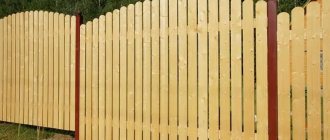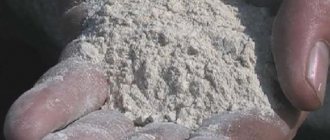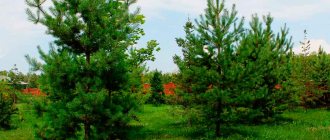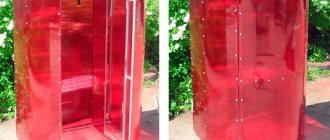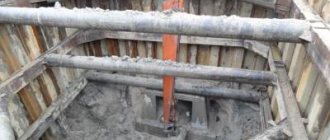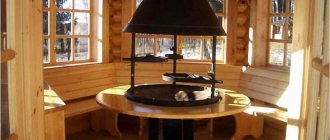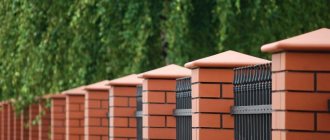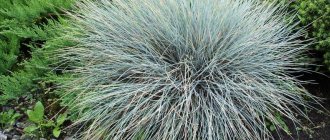Fruit bushes and trees look beautiful on the site during the spring flowering period. And if you plant conifers in the yard, they will look aesthetically pleasing both in summer and winter. That is why these plants are in great demand among gardeners when improving their garden plots.
In this article we will look at the main advantages and disadvantages of planting conifers on the site, which varieties are best to plant, how to do it correctly and much other useful information.
Growing coniferous trees in a garden plot
The conifers on the site not only look great at any time of the year, but also purify the air and imbue it with an unobtrusive and pleasant aroma of pine needles. Breeders have bred such a huge number of thujas, junipers, pines and small firs that even the most demanding gardener will definitely select the variety for the plot that will become its main decoration.
Advantages
The main advantages of planting conifers on the site include:
- a large assortment of trees and shrubs;
- ease of care;
- long lifespan;
- resistance to negative factors (drought, frost);
- aesthetic evergreen appearance;
- harmonious combination with other decorative dwarf trees and shrubs, for example, rhododendrons, barberries, hydrangeas;
- environmental friendliness. Conifers secrete essential oils that purify the air and saturate it with the scent of the forest.
Flaws
As for the disadvantages of planting conifers on the site, there are practically none. The only thing is that some gardeners have noticed that the close proximity of some conifers (such as junipers) next to fruit trees (for example, pears) can infect them with fungal diseases (rust on the leaves).
But when planting a pine tree, it is worth considering that it is very responsive to the air around it. It is not recommended to plant it next to the roadway, as from exhaust gases, dust and smoke, the needles on the pine will begin to turn yellow, and the tree itself will wither.
Also, one of the disadvantages of planting pine on a site is that if the wrong variety is chosen, the tree in adulthood can reach enormous sizes and greatly darken the site.
Attention : do not plant pine trees near buildings. They have too powerful a root system, which over time can destroy the foundation.
Diseases
Fungal infections
Fungal diseases characteristic of pine most often develop as a result of high humidity, lack of light or poor ventilation.
- Pine spinner
Main symptom: twisted zigzag branches. Treatment: Bordeaux mixture, polycarbacin 1%.
- Necrosis
Signs: partial death of lower branches and needles, black spots or plaque on the entire tree, needles lose color saturation. Treatment: Bordeaux mixture 1%.
- Biatorella cancer
Signs: darkening of the trunk, dark wood cankers with resin deposits on the north side, locally yellowing needles. A deadly disease: in most cases the pine tree dies. Treatment: Bordeaux mixture, copper sulfate.
- Rotten
Signs: needles turn yellow, bark falls off in whole pieces, trunk voids form. An insidious disease that can wear away a tree from the inside for years without obvious symptoms. Treatment: any fungicide.
- Rust
The main symptom: brown, orange or yellow growths on the trunk, needles and branches. By the beginning of summer, the needles turn yellow and fall off. Treatment: drugs with a high concentration of copper - Kuproxat, Oksikhom.
- Powdery mildew
Signs: small drops thickly covering the needles, which darken and fall off. Treatment: foundationazole, colloidal sulfur.
- Snow shutte
Signs: dark spots on the needles that turn gray or pale brown and subsequently fall off. Treatment: fungicides.
- Fusarium
Signs: needles turn yellow, thin out, dry out. When symptoms become noticeable, treatment is useless: the tree dies.
- Verticillium wilt
Signs: needles lighten, soften and turn yellow. Treatment: any fungicides, reducing soil alkalinity, thoroughly loosening the tree trunk.
Related articles: Diseases and pests of coniferous plants
Pests
Pine needles are a treat for pests such as:
- pine silkworm;
- red sawfly;
- red-headed sawfly;
- pine moth;
- pine cutworm;
- pine hawkmoth;
- pine scale insect;
- spider mite
The bark and shoots are loved by insects such as:
- brown aphid;
- subcortical bug;
- shootweed;
- spot tar;
- pine longhorned beetle;
- blue borer.
When pests invade, insecticides are used - Bitoxibacillin, Lepidocid, Lepidobactocid, Confidor, Actellik.
Whatever disease overtakes the decorative pine, first of all it is necessary to remove all affected parts of the tree and burn it outside the garden. And when processing, spray not only the crown, but also the entire tree trunk circle. Preferably, neighboring plants too.
Types of conifers that are most often planted in the country
Among the huge variety of coniferous trees that can decorate any landscape design, gardeners give preference to the following types and varieties.
Sosnovym
These include: larch, fir, spruce, cedar. They are distinguished by a variety of shapes and colors. Dwarf varieties are actively used in the design of rockeries and rock gardens. They are easy to care for and look beautiful in landscape designs.
Kiparisov
The most common conifers that fit harmoniously into various landscape designs. Their crown has a pyramidal shape and takes a long time to grow back after pruning. This type of conifer is completely unpretentious in care, it is not attacked by pests, it rarely gets sick, and it tolerates any negative environmental factors well. In addition, cypress trees purify the air and fill it with phytoncides, which prevent the growth and development of harmful bacteria.
Attention: the aroma of cypress trees perfectly repels various insects, especially mosquitoes, so it is recommended to plant them in recreation areas.
Tisov
This type of conifers is suitable for those who like to admire evergreen trees, but do not like the smell of pine needles. Yew trees are suitable for creating aesthetic compositions and for arranging rock gardens. Their height varies from 5 to 20 m. Their needles are lush green in color, up to 3 cm long. The crown is dense and semicircular.
Attention: when planting yew trees on your site, remember that they are poisonous. Therefore, you need to work with them carefully.
Pine in the garden
Pine trees on a summer cottage will give it an aristocratic and respectable appearance. With their help, interesting compositions are created. They land both solo and in groups. These plants are unpretentious to soil fertility. They thrive on sandy, loamy and rocky soils.
Examples of beautiful landscape compositions with conifers for a country house
There are a huge number of examples of beautiful landscape compositions with conifers for a country house in the world of the Internet. Or use the services of a landscape designer who will bring all your ideas and attitude to life.
Ensembles of coniferous plants will harmoniously fit into the landscape of your garden plot. And spot landing will add additional charm.
Which type of wood to choose
For those who are interested in pine in the country, it is worth taking a responsible approach to choosing its variety. And they come in different shapes, colors, sizes.
Fastigiata
A beautiful tree with a narrow columnar crown. Reaches a height of 10 m, but grows very slowly. In 25 years it grows only 5.5 m. The annual growth is 20 cm in height and 5 cm in width.
This variety is often used in landscape design due to the beautiful bluish tint of the needles. The plant loves light. But it also grows in the shade (in this case its blue tint disappears). It is not demanding on soil, but it is recommended to plant it on loose, well-drained and moist soil.
Glauka
If you want to plant a pine tree near your house, you should pay attention to the Glauka variety. It is characterized by the blue-green color of the needles, a lush and luxurious crown, and a pleasant aroma. Over 30 years of growth on the site, it reaches only a height of 4-6 m. It grows very slowly, and the annual growth is only 8 cm. The plant is unpretentious in care.
Siberian cedar
The Siberian cedar pine in the garden will become a worthy decoration. It grows quite quickly at 40 cm per year. But for the first ten years after planting, the tree grows only to a height of 1.7 m. Its needles are dark green, dense and hard. The cones are large, ovoid, about 13 cm long and 8 cm wide. In addition to aesthetics, the tree purifies the air, strengthens creeping slopes, protecting them from landslides.
Attention: Siberian cedar begins to bear fruit only at the age of 20 years.
Compact Jam
The whitebark variety of this pine is considered a real find for most gardeners. After all, this slow-growing tree is distinguished by its small size and neat aesthetic appearance. It has long, dark green needles, densely covering the branches, and a beautiful symmetrical crown. This variety is often found on alpine hills, rocky gardens, and in various flower arrangements.
Blue Shag
It is distinguished by its compact crown, blue tint, and undemanding conditions for growing. Its height in the wild reaches 30 m. The crown of seedlings is pyramidal, becoming horizontal with age. Cones appear on the tree when it reaches 25 years of age. They are cylindrical, narrow and slightly curved.
Pyramidalis
Quite a tall tree with a narrow pyramid-shaped crown. Its height can reach 8 m, diameter - up to 3 m. Annual growth is 40 cm. In mature trees, the crown becomes wide and ovoid. The needles are dark green, 9 cm long. The variety is completely undemanding to the soil, prefers sunny meadows, and is resistant to negative factors.
Compacta
This is an ordinary pine, which looks prestigious and respectable on the site. It is a wide shrub, reaching a height of up to 2.5 m. Conifer grows slowly. The maximum annual growth is 15 cm. The plant loves the sun, is undemanding to soil fertility, but is sensitive to polluted air.
How to plant?
A dwarf ornamental pine purchased from a nursery must be planted correctly. If you plan to grow in a pot, the procedure will be as follows.
A prepared ceramic or plastic container with a diameter of 10-15 cm, in the bottom of which there are holes for drainage, is poured with boiling water to prevent bacterial contamination.
Drainage in the form of expanded clay or gravel is laid at the bottom. Activated carbon tablets are placed on top. Soil is being added.
Fertile soil is prepared from a mixture of equal amounts of coarse sand and leaf soil or peat. The soil is poured into a mound in the center of the pot.
A seedling with roots removed from the container is freed from the soil. Old dried or rotten roots are removed. The sections are treated with activated carbon powder. The seedling is placed in a container with prepared soil and sprinkled with earth.
After the transplant is completed, the dwarf pine is sent to a semi-shady place for up to 2 weeks. The plant is watered abundantly and sprinkled. It is worth considering that for growing dwarf forms, it is recommended to take pots of a smaller diameter than those used in the nursery. Then the growth of the seedling will be inhibited.
Features of plant care
As for caring for conifers, it is important only in the first few years after planting the seedling. At this time, the tree is watered abundantly (at least once a week, based on up to 10 liters of water per seedling), the soil is loosened, mulched, and fertilized several times with complex fertilizers (but this is recommended to be done only a year after planting the plant). But trees that have reached the age of 6-8 years no longer need special care. There are enough of them:
- water periodically (during dry summers);
- feed with compost or special preparations two to three times a year;
- prune if necessary.
Attention : heat-loving plants must be covered for the winter. This is especially true for young seedlings.
How to care?
Subsequent care for decorative pine involves placing the plant in a pot outdoors in the summer. The tree is left in partial shade, providing it with protection from the scorching rays of the sun. A seedling in a pot is watered daily in the warm season, the needles are sprayed with settled or well water from a spray bottle. In autumn, the supply of moisture is reduced; in winter, it is provided only when necessary so that the soil does not dry out.
Young pines need feeding throughout the summer and spring seasons. It is performed monthly, applying 1/2 the dosage for plants in pots, as well as the full recommended dose for seedlings grown in open ground. Special ready-made mixtures for conifers are used.
For information on decorative pines, see the following video.
The use of pine trees in the garden landscape
Studying the pros and cons of planting pine in the garden, it is worth noting that a dwarf tree is still worth planting, as it looks unusually beautiful, enriches the air, and fertilizes the soil. Conifers look luxurious in different types of planting: solo, group, on lawns, in flower arrangements. Dwarf varieties are actively used in the arrangement of rockeries and rock gardens. They are also often found when arranging front areas.
In conclusion, it is worth noting that by planting a beautiful and low conifer on the site, you will make it more noble, aristocratic and aesthetic. These plants will not take up much of your time, as they require virtually no care. But they will delight the owners with a beautiful and evergreen appearance at any time of the year.

